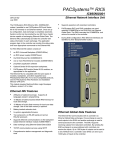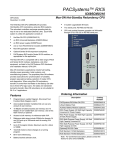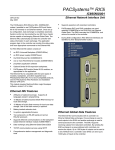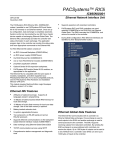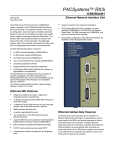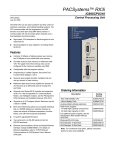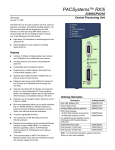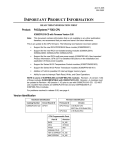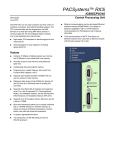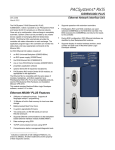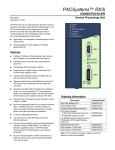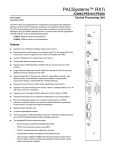Download PACSystems RX3i Max-ON CPU IC695CMU310, GFK
Transcript
PACSystems™ RX3i
IC695CMU310
GFK-2420
November 2005
The RX3i Max-ON CPU IC695CMU310 provides HotStandby CPU redundancy using two RX3i systems. The
redundant PLCs exchange operating data by way of one
or two dedicated Ethernet LANs. Each RX3i system in a
Max-On application consists of:
▪
▪
▪
▪
▪
▪
▪
Max-ON Hot-Standby Redundancy CPU
▪
▪
Two serial ports: RS-485 and RS-232.
CPU and module firmware upgrades via Winloader
through CPU’s RS-232 or RS-485 serial port.
CPU OK
RUN
OUTPUTS DISABLED
the Max-ON CPU (IC695CMU310)
I/O FORCE
an RX3i Universal Backplane (IC695CHS0xx)
BATTERY
SYSTEM FAULT
an RX3i power supply (IC695PSxxxx)
one or more RX3i Ethernet modules (IC695ETM001)
Max-ON application software
Optional Series 90-30 expansion backplanes.
RESET
STOP
CMU310
RUN I/O
ENABLE
RUN OUTPUT DISABLE
COM 1
PACSystems RX3i and/or Series 90-30 modules, as
appropriate for the application.
The Max-ON CPU is compatible with a wide range of RX3i
and Series 90-30 modules, backplanes, and other
equipment, as listed in the PACSystems RX3i Hardware
and Installation Manual, GFK-2314.
COM1 ACTIVE
COM1 ACTIVE
Max-ON redundancy applications include fuel loading,
standby power generation, boiler systems, and
manufacturing systems. The proprietary Max-ON software
provides subroutines for synchronization of variables,
program equivalence testing, selection of master CPU,
and diagnostics. Max-ON redundancy is not bumpless;
transfer of control can take two to three CPU logic scans.
I/O states are maintained during the transfer. Max-ON
redundancy is not suitable for SIL 2 or 3 applications.
Features
▪ Programming in Ladder Diagram, Structured Text,
▪
▪
▪
▪
▪
▪
▪
▪
▪
COM 2
BATT
Ordering Information
Description
Catalog
Number
and C.
PACSystems RX3i Max-ON CPU
IC695CMU310
Auto-located Symbolic Variables that can use any
amount of user memory.
Lithium Battery Pack
IC698ACC701
10 Mbytes of battery-backed user memory and 10
Mbytes of non-volatile flash user memory. Use of this
flash memory is optional.
Auxiliary Battery Module (optional)
IC693ACC302
RX3i Power Supply, 40 Watt High Capacity
Universal AC Power Supply
IC695PSA040
Access to bulk memory via reference table %W.
RX3i Power Supply, 40 Watt High Capacity
24 VDC Power Supply
IC695PSD040
Reference table sizes include 32Kbits for discrete %I
and %Q and up to 32Kwords each for analog %AI
and %AQ.
RX3i Multi-Purpose Power Supply, 40 Watt
High Capacity Universal AC
IC695PSA140
RX3i Multi-Purpose Power Supply, 40 Watt
High Capacity 24 VDC
IC695PSD140
Up to 512 program blocks. Maximum size for a block
is 128KB.
Test Edit mode to check changes to a running
program.
Bit-in-word referencing.
Battery-backed calendar clock.
In-system upgradeable firmware.
[Optional] RS-232 Cable
IC200CBL001
Rx3i Standard 12 Slot Backplane
IC695CHS012
Rx3i Standard 16 Slot Backplane
IC695CHS016
Note: For Conformal Coat option, please consult the
factory for price and availability.
2
RX3i Max-ON Hot-Standby Redundancy CPU
GFK-2420
Specifications
Battery: Memory
retention
Program storage
For estimated battery life under various
conditions, refer to the PACSystems
CPU Reference Manual, GFK-2222.
Up to 10 Mbytes of battery-backed RAM
10 Mbytes of non-volatile flash user
memory
replacing the battery, be sure to install a new battery
before disconnecting the old one.
To avoid loss of RAM memory
contents, maintenance
procedures should include
scheduled replacement of the
battery pack. For information on
estimating battery life, refer to the
PACSystems CPU Reference
Manual, GFK-2222. Disposal of
lithium batteries must be done
in accordance with federal,
state, and local regulations. Be
sure to consult with the appropriate
regulatory agencies before
disposing of batteries.
RESET
STOP
RUN I/O
ENABLE
RUN OUTPUT DISABLE
Power
requirements
+3.3 VDC: 1.25 Amps nominal
+5 VDC: 1.0 Amps nominal
Operating
Temperature
0 to 60°C (32°F to 140°F)
Floating point
Yes
Boolean
execution speed
0.195ms per 1000 Boolean
contacts/coils, typical
Time of Day
Clock accuracy
Maximum drift of 2 seconds per day
Elapsed Time
Clock (internal
timing) accuracy
0.01% maximum
Embedded
communications
RS-232, RS-485
Serial Protocols
supported
Modbus RTU Slave, SNP, Serial I/O
Backplane
Dual backplane bus support: RX3i PCI
and 90-30-style serial
Operation of the CPU can be
controlled by the three-position
RUN/STOP switch or remotely by
an attached programmer and
programming software. Program
and configuration data can be locked through software
passwords.
PCI compatibility
System designed to be electrically
compliant with PCI 2.2 standard
LEDs
Program blocks
Up to 512 program blocks. Maximum
size for a block is 128KB.
Memory
%I and %Q: 32Kbits for discrete
%AI and %AQ: configurable up to
32Kwords
%W: configurable up to the maximum
available user RAM
Symbolic: configurable up to 10 Mbytes
Programmer
Proficy Machine Edition Logic Developer
Release 5.5 SIM 1 or later is required to
enable use of the RX3i NIU.
For environmental specifications and compliance to
standards (for example, FCC or European Union
Directives), refer to the PACSystems RX3i Hardware and
Installation Manual, GFK-2314.
Battery
A three-cell lithium battery pack (IC698ACC701) maintains
data memory when power is removed and operates the
calendar clock. For maximum battery life, do not connect
the battery for the first time until the CPU is installed in the
backplane and the backplane is powered on. The battery
may then be attached to either of the two terminals in the
battery compartment as shown at right. Program and initial
values load from flash when the CPU powers up. When
Run/Stop Switch
CPU status is indicated by the CPU LEDs on the front of
the module. The following table lists the LED functions
during normal operation (after initialization is complete).
CPU OK
(Green)
RUN
(Green)
OUTPUTS
ENABLED
(Green)
CPU OK,
OUTPUTS
ENABLED,
RUN
I/O FORCE
BATTERY
SYSTEM
FAULT
COM1
COM2
On
Off
On
Off
On
Off
Blink in
unison
Blink
pattern
On
(Yellow)
Blinking
On
(Red)
On
(Red)
Blinking
CPU has passed powerup diagnostics
and is functioning properly.
CPU problem. See below.
CPU is in Run mode
CPU is in Stop mode.
Output scan is enabled.
Output scan is disabled.
CPU is in boot mode and is waiting for
a firmware update through serial port.
If CPU OK is off and RUN and
OUTPUTS ENABLED blink in an error
code pattern, report the condition and
blink codes to your technical support
representative for troubleshooting.
Override is active on a bit reference.
Battery is low.
Battery is dead or not attached.
CPU is in Stop/Faulted or Stop/Halted
mode.
Signal activity on port.
RX3i Max-ON Hot-Standby Redundancy CPU
3
November 2005
GFK-2420
Serial Ports
Pin
Signal
Description
1*
Shield
Cable Shield
2
NC
No Connection
3
NC
No Connection
4
NC
No Connection
5
+5VDC
Logic Power**
6
RTS(A)
Differential Request to Send
7
0V
Signal Ground
8
CTS(B‘)
Differential Clear To Send
Both ports provide communications at: 1200, 2400, 4800,
9600, 19.2K, 38.4K, 57.6K, 115.2K baud for all protocols
except when upgrading firmware with Winloader. In that
case, 1200 baud is not available.
9***
RT
Resistor Termination
Port 1
The CPU has two independent, on-board DCE (data
communications equipment) serial ports, accessed by
connectors on the front of the module.
Both ports support RTU slave, SNP slave, Serial I/O*
Message Mode (C Runtime Library Functions:
serial read, serial write, sscanf, sprintf). Either port can be
used for firmware upgrade wth the RX3i in STOP/No I/O
mode.
Port 1 (COM1) is RS-232 compatible. It has a 9-pin,
female, D-sub connector with a standard pin out. Port 1
allows a simple straight-through serial cable to connect
with a standard AT-style RS-232 port. Maximum cable
length from the CPU to the last device attached to the
serial cable is 15 meters (50 ft). This connection can be
made with the IC200CBL001 cable kit, or with a custom
cable. Use of shielded cable is optional. The COM1
Active LED provides the status of serial port activity.
10**
RD(A‘)
Differential Receive Data
11
RD(B‘)
Differential Receive Data
12
SD(A)
Differential Send Data
13
SD(B)
Differential Send Data
14
RTS(B)
Differential Request To Send
15
CTS(A’)
Differential Clear To Send
*
Pin 1 is at the bottom right of the connector as viewed from
the front of the module.
**
Pin 5 provides isolated +5VDC power (300mA maximum)
for powering external options.
*** Termination resistance for the RD A’ signal should be
connected on units at the end of the line. To make this
termination, connect a jumper between pins 9 and 10
inside the 15-pin D-shell.
Programmer Connection
Pin
*
Signal
Description
1*
NC
No Connection
2
TXD
Transmit Data
3
RXD
Receive Data
4
DSR
Data Set Ready
5
0V
Signal Ground
6
DTR
Data Terminal Ready
7
CTS
Clear To Send
8
RTS
Request to Send
9
NC
No Connection
Pin 1 is at the bottom right of the connector as viewed from the
front of the module.
The programmer can communicate with the CPU via serial
port 1, serial port 2, or the backplane-based Ethernet
interface. Connecting a programmer via an Ethernet
TCP/IP network requires a CAT5 standard Ethernet cable
with RJ-45 connectors. Before connecting the programmer
and CPU to the Ethernet TCP/IP network, set the IP
address using the Initial IP Address software tool. After
setting the IP address, connect the RX3i and the computer
running the programming software to the Ethernet
Interface. For detailed information on programmer
connection via Ethernet TCP/IP, refer to the TCP/IP
Ethernet Communications for PACSystems User’s
Manual, GFK-2224.
Port 2
Installation
Port 2 (COM2) is RS-485 compatible. Port 2 has a 15-pin,
female D-sub connector and supports the RS-485 to RS232 adapter (IC690ACC901). Maximum cable length from
the CPU to the last device attached to the serial cable is
1200 meters (4000 ft). Shielded cable is required. The
COM2 Active LED provides the status of serial port
activity.
It is the responsibility of the OEM, system integrator, or
end user to properly install the control system equipment
for safe and reliable operation.
Installation should not be attempted without referring to
the PACSystems RX3i Hardware and Installation Manual,
GFK-2314.
1.
Make sure that backplane power is off.
4
RX3i Max-ON Hot-Standby Redundancy CPU
GFK-2420
2.
Install the CPU module in RX3i backplane 0. The
CPU requires two slots and can use any slots except
the highest numbered (rightmost) slot. More
information on slot selection follows. Be sure the
mounting screws are tightened to completely secure
the CPU to the backplane.
3.
Turn on power. The CPU should power up. When the
CPU has successfully completed initialization, the OK
LED stays on and the RUN and EN LEDs are off.
The CPU is now ready to be programmed.
4.
To save battery life, do not connect the battery for the
first time until the CPU is installed in the backplane
and the backplane powered on. The battery may then
be attached to either of the two terminals in the
battery compartment. Once that is done, the CPU
may be powered down and normal battery back up
operation will begin.
Backplane Locations for the CPU
The Max-ON CPU IC695CMU310 is a doublewide module
whose connector is right-justified as viewed when installed
in a backplane. The CPU is referenced for configuration
and application logic by the leftmost slot occupied by the
entire module, not by the slot the physical connector is
located in. For example, if the CPU has its physical
connector inserted in slot 3, the module occupies slots 2
and 3 and the CPU is referenced as being located in slot
2. The CPU may be located in slot 0 with its connector in
slot 1. The CPU cannot be located in slot 11 of a 12-slot
backplane or in slot 15 of a 16-slot backplane, because its
connector cannot be installed in the slot reserved for an
expansion module.
The RX3i AC Power Supply (IC695PSAx40) is a
doublewide module whose connector is left-justified as
viewed when installed in a backplane. It cannot be
located in slot 11 of a 12-slot backplane or slot 15 of a 16slot backplane. No latch mechanism is provided for the
last (rightmost) slot in a backplane, so it is not possible to
place the power supply in the second to last slot.
standard 0.1 location, but the slot the CPU is located in.
Logic that decodes fault table entries retrieved by these
service requests may need updating.
COMMREQs directed to the CPU (e.g. those directed to
the serial ports of the CPU) will need to be updated with
the correct CPU slot reference.
Hardware Configuration: The slot location of the CPU
must be updated in the hardware configuration to reflect
the CPU’s true location.
Fault Tables: Faults logged for the CPU in the fault table
will reflect the CPU’s actual slot.
Remote Series 90 PLCs that use SRTP Channels
COMMREQs expect the CPU to be in slot 1 or slot 2. To
support communications with Series 90 SRTP clients such
as Series 90 PLCs using SRTP Channels, the RX3i
internally redirects incoming SRTP requests destined for
{backplane 0, slot 1} to {backplane 0, slot 2}, provided that
the CPU is located in backplane 0 slot 2 (and the remote
client has not issued an SRTP Destination service on the
connection to discover the backplane and slot of the
CPU). This special redirection permits Series 90-30
applications that expect the power supply to be located
leftmost and the CPU to be located to the right of the
power supply to function. Attempts to establish channels
with CPUs in slots other than 1 or 2 will fail if initiated from
Series 90 PLCs.
All external communication devices that interact with
the CPU should be checked for compatibility with CPU
slot locations other than slot 1. Problems may arise with,
but are not limited to, initial connection sequences and
fault reporting. Machine Edition View users should select
“GE SRTP” as their communications driver – it can
communicate with a CPU in any slot.
Installation in Hazardous Locations
▪
Locating the CPU in Slot 1
Installing the CPU in slot 1 means that only a singlewide
power supply may be used in slot 0. Either DC power
supply can be used (IC695PSD040 or IC695PSD140). If
the application must maintain a slot 1 CPU and uses an
AC power-supply, the RX3i AC power-supply must be
located in a slot to the right of the RX3i CPU in slot 1.
Locating the CPU in a Slot Other than 1
Before deciding to place the CPU in a slot other than slot
1, it is important to consider possible issues that could
arise, as explained below.
Communications: For Service Request #15 (Read LastLogged Fault Table Entry) and Service Request #20
(Read Fault Tables), the location of CPU faults is not the
▪
▪
▪
EQUIPMENT LABELED WITH REFERENCE TO
CLASS I, GROUPS A, B, C & D, DIV. 2
HAZARDOUS LOCATIONS IS SUITABLE FOR USE
IN CLASS I, DIVISION 2, GROUPS A, B, C, D OR
NON-HAZARDOUS LOCATIONS ONLY
WARNING - EXPLOSION HAZARD SUBSTITUTION OF COMPONENTS MAY IMPAIR
SUITABILITY FOR CLASS I, DIVISION 2;
WARNING - EXPLOSION HAZARD - WHEN IN
HAZARDOUS LOCATIONS, TURN OFF POWER
BEFORE REPLACING OR WIRING MODULES; AND
WARNING - EXPLOSION HAZARD - DO NOT
CONNECT OR DISCONNECT EQUIPMENT
UNLESS POWER HAS BEEN SWITCHED OFF OR
THE AREA IS KNOWN TO BE NONHAZARDOUS.
RX3i Max-ON Hot-Standby Redundancy CPU
5
November 2005
GFK-2420
Configuration
Ethernet Global Data (EGD)
The Max-ON CPU and RX3i system are configured with
Machine Edition PLC-Logic Developer programming
software.
Each RX3i CPU supports up to 255 simultaneous Ethernet
Global Data (EGD) exchanges across all Ethernet
interfaces in the PLC. EGD exchanges must be configured
in the programming software and stored into the CPU. The
EGD configuration can also be loaded from the CPU into
the programming software. Both produced and consumed
exchanges can be configured. RX3i CPUs support using
only part of a consumed EGD exchange, and EGD
exchange production and consumption to the broadcast IP
address of the local subnet.
The CPU verifies the actual module and backplane
configuration at power-up and periodically during
operation. The actual configuration must be the same as
the programmed configuration. Deviations are reported to
the CPU alarm processor function for configured fault
response. Refer to the Proficy Machine Edition Logic
Developer-PLC Getting Started Manual, GFK-1918 and
the online help for a description of configuration functions.
The redundancy application is configured using the MaxON configuration tool located in Max-ON 3i Tools. It is
launched by double-clicking on a file located in the Proficy
ladder project. The configuration tool is used to define the
redundancy parameters such as Ethernet IP addresses,
device status addresses, and module locations. The MaxON configuration tool also defines the synchronized data
groups that will be transferred from the Master PLC to the
Backup PLC if needed.
The RX3i CPU supports 2msec EGD exchange production
and timeout resolution. RX3i EGD exchanges can be
configured for a production period of 0, indicating the
exchange is to be produced every output scan. These “as
fast as possible” exchanges are not produced more often
than 2msec. RX3i CPUs support enhanced EGD
freshness, providing better EGD timeliness.
Release History
Catalog Number
FW Revision
Comments
IC695CMU310-AA
3.51
Initial Release
Known Restrictions for this Release
Subject
Description
1.
Automatic detection of reference address overlaps, module rack/slot overlaps, and
synchronized data overlaps is not available.
2.
This release does not monitor the quantity of configuration memory allocated for the project.
Configuration memory is used to define Genius I/O devices and analog input scaling.
Configuration memory is limited to approximately 1000 devices and/or scaled groups.
Max-ON software
3.
Battery installation
CPU sweep time
impacted when high
temperature warning
is active
Ethernet Disconnect
During Word for
Word Change
Simultaneous Clears,
Loads and Stores
Not Supported
Power Cycle During
Write to Flash
Automatic report generation is not available. A temporary work-around is to use the
information that is displayed in the Status Window. The text may be selected and copied
and pasted into another application.
When installing a new battery, if no battery is currently installed, the new battery must be
installed while the CPU has power. Failing to follow this procedure could result in the CPU not
powering up. Recommendation: remove the battery, power-cycle the CPU, then re-install the
battery.
When the processor temperature is above the high temperature-warning threshold (at which
point a fault is logged), the sweep time may be impacted (i.e. periodically the sweep may be
extended ). It is important to note that the processor is still running at full speed. The sweep
impact is a result of delays in the interface between the CPU and the temperature-sensing part.
If the Ethernet connection is broken during a word–for-word change, the programmer may not
allow a subsequent word-for-word change after reconnecting. Recommendation: go offline and
then back online again.
Multiple programmers may not change CPU contents at the same time. The programming
software may generate an error during the operation. Simultaneous loads from a single CPU
are allowed.
The CPU is configured to power up from flash and if is power-cycled while writing to flash, a fault
is generated on power up.
6
RX3i Max-ON Hot-Standby Redundancy CPU
GFK-2420
Subject
Hardware
Configuration Not
Equal After Changing
Target Name
PLC and IO Fault
Tables May Need to
be Cleared Twice to
Clear Faulted State
Setting Force On/Off
by Storing Initial
Value
Number of Active
Programs Returned
as Zero
Serial I/O Failure at
115K During Heavy
Interrupt Load
SNP ID not always
provided
Second programmer
can change logic
while in Test & Edit
mode
CPU may not detect
low-battery condition
Two loss of module
faults for Universal
Analog Module
Power up of Series
90-30 HSC module
may take up to 20
seconds
Info fault at power up
Extended Memory
Types for I/O
Triggers
Possible ME inability
to connect
SNP Update
Datagram message
GBC30 may not
resume operation
after power cycle
Configuration of
third-party modules
Power supply status
after CPU firmware
update
Power supply status
Description
If a hardware configuration is stored to flash that sets “Logic/Config Power up Source” to “Always
Flash” or “Conditional Flash” and the name of the target is subsequently changed in the
programming software, the hardware configuration will go Not Equal and will not Verify as equal.
Both PLC and IO fault tables may need to be cleared to take the CPU out of Stop/Fault mode. If
one of the tables contains a recurring fault, the order in which the tables is cleared may be
significant. Recommendation: if the CPU is still in Stop/Fault mode after both tables are cleared,
try clearing the fault tables again.
After a force on or force off has been stored to the CPU, it cannot be switched from force on to
force off or vice-versa by downloading initial values. Recommendation: turn off the force by
doing a download, and then change the force on or off by another download.
The SNP request Return Controller Type and ID currently returns the number of active programs
as zero.
Rarely, data corruption errors occur during serial communications when running at 115K if there
is a heavy interrupt load on the CPU. Recommendation: under heavy load applications, restrict
serial communications to 57K or lower.
The CPU’s SNP ID does not appear in the Machine Edition programmer Show Status display.
Service Request 11 will always return zeros.
While currently active in a Test and Edit session using Machine Edition on one PC, Machine
Edition running on another PC is not prevented from storing new logic to the CPU.
A battery with very low capacity may still have a terminal voltage high enough to report that it is a
good battery. When the battery starts supplying the memory power (battery backup), the battery
voltage quickly drops to unacceptable levels, and it may fail. Recommendation: replace
batteries in accordance with the guidelines provided in the CPU Reference Manual, GFK-2222.
In addition, logic and hardware configuration can be saved to flash.
Occasionally, the hot removal of the Universal Analog Input Module (IC695ALG600) results in
two “Loss of I/O Module” faults instead of one.
As power is applied to a 90-30 High-Speed Counter, the "module ready" bit in the status bits
returned each sweep from the module may not be set for as long as 20 seconds after the first
CPU sweep, even though there is no "loss of module" indication. I/O data exchanged with the
module is not meaningful until the module has set this bit.
Intermittently during power-up, an Informational non-critical CPU software fault may be
generated with fault extra data of 01 91 01 D6. This fault has no effect on normal operation of
the CPU. But if the hardware watchdog timer expires after this fault and before power has been
cycled again, the outputs of I/O modules may hold their last state, rather than defaulting to zero.
%R, %W and %M cannot be used as I/O triggers.
Infrequently, an attempt to connect a programmer to an CPU via Ethernet is unsuccessful. The
normal connection retry dialog is not displayed. Recommendation: Reboot the computer that is
running the programmer.
If an Update Datagram message requests 6 or fewer bits or bytes of data, the CPU returns a
Completion Ack without Text Buffer. The protocol specifies that the returned data should be in
the Completion Ack message, but it may not be.
In rare instances, a GBC30 in an expansion backplane may not resume normal operation after a
power cycle of either the expansion backplane or the main backplane.
Do not specify a length of 0 in the configuration of a third-party module. The module will not
work properly in the system.
The CPU reports a “Loss of or missing option module” fault for the IC695PSD140 RX3i power
supply following an update of CPU firmware. The slot appears empty in the programmer’s online
status detail view. The power supply continues to operate normally. Recommendation: Power
cycle to restore normal status reporting.
Rarely, turning a power supply on or off may not result in an add or loss fault. Also, the slot will
RX3i Max-ON Hot-Standby Redundancy CPU
7
November 2005
Subject
after power cycling
Don’t use multiple
targets
Missing “Loss of
terminal block” fault
Sequence Store
Failure
IC694MDL754: Must
configure module
status bits
PID algorithm
IC695ALG600 Lead
Resistance
Compensation
setting
C Toolkit
PlcMemCopy
Documentation
Incorrect
Genius Device I/O
Enable LED Does Not
Illuminate If No
Output Module
Present on Genius
Bus
GFK-2420
Description
appear empty in the programmer’s online status detail view. The power supply continues to
operate normally. Power cycle to restore normal status reporting.
In a system in which the hardware configuration is stored from one target and logic is stored
from a different target, powering-up from flash will not work. The observed behavior is that,
following a power up from flash, ME reports hardware configuration and logic "not equal".
The IC695ALG600/608/616 analog input modules do not produce a “Loss of terminal block” fault
if the hardware configuration is stored or the module is hot-inserted when the terminal block is
not locked into place.
Writing a very large hardware configuration to flash may cause a “PLC Sequence Store Failure”
error. To work around this error, either:
1. Perform an explicit clear of flash prior to performing the write.
2. Increase the operation timeout used by ME prior to performing the write.
Always configure 16 bits of module status when using this module. Configuring 0 bits of module
status will result in invalid data in the module’s ESCP status bits.
If bit 2 is set to 1 and bit 0 is set to 1, the product will operate in a manner opposite to the
description in user manual GFK-2222D or earlier. The derivative term is added when it should
be subtracted.
A configuration store operation fails if a channel is configured for 3-wire RTD with Lead
Resistance Compensation set to Disabled. A Loss of Module fault is logged in the I/O Fault
table at the end of the store operation. Recommendation: to recover the lost module, change
the configuration to enable Lead Resistance Compensation and power-cycle the module.
This routine does allow the destination and source pointers to be outside of reference memory.
If the destination points to discrete reference memory, overrides and transitions are honored.
If a Genius Bus contains no output Genius devices, the I/O Enable LEDs for the input Genius
devices do not illuminate when the CPU is placed in RUN Mode. The modules function properly
even though the status LED is not lit. If an output Genius device is present on the Genius bus,
the I/O Enable LED will illuminate for all input and output Genius devices when the CPU is
placed in RUN Mode as expected.
Operating Notes
Subject
LD-PLC operations
Logic Executed in
Row Major Instead of
Column Major
Changing IP Address
of Ethernet Interface
While Connected
Duplicate Station
Address for Modbus
Will Conflict with
Other Nodes
Timer Operation
Description
The connect and download functions are now separate in Machine Edition LD-PLC. To perform a
download to the CPU, you must first connect to the CPU.
Logic execution in PACSystems RX3i is performed in row major order (similar to the Series 9030). This is different from the Series 90-70, that executes in column major order. This means that
some complicated rungs may execute slightly differently on PACSystems RX3i and Series 90-70.
For specific examples, see the programming software on-line help.
Storing a hardware configuration with a new IP address to the RX3i while connected via Ethernet
will succeed, then immediately disconnect because the RX3i is now using a different IP address
than the Programmer. You must enter a new IP address in the Target Properties in the Machine
Edition Inspector window before reconnecting.
The default serial protocol for the RX3i is Modbus RTU. The default Station Address is 1. If the
CPU is added to a multi-drop network, care must be taken that the CPU is configured with a
unique Station Address. Nodes with duplicate Station Addresses on the same network will not
work correctly.
Care should be taken when timers (ONDTR, TMR, and OFDTR) are used in program blocks that
are NOT called every sweep. The timers accumulate time across calls to the sub-block unless
they are reset. They function like timers operating in a program with a much slower sweep than
the timers in the main program block. For program blocks that are inactive for large periods of
time, the timers should be programmed to account for this catch up feature. Related to this are
timers that are skipped because of the use of the JUMP instruction. Timers that are skipped will
NOT catch up and will not accumulate time as though they were executed every sweep.
8
RX3i Max-ON Hot-Standby Redundancy CPU
GFK-2420
Subject
Description
Large Number of
COMMREQs Sent to
Module in One Sweep
Causes Faults
A large number of COMM_REQs (typically more than 8) sent to one module in the same sweep
may cause Module Software faults to be logged in the PLC fault table. The fault group is
MOD_OTHR_SOFTWR (16t, 10h) and the error code is COMMREQ_MB_FULL_START (2). The
“FT” output of the function block is also set. Recommendation: Spread multiple COMMREQs to
the same module across multiple sweeps so that fewer (typically 8 or less) are sent to the module
in each sweep. Also, check the FT output parameter for errors. If the FT output is set (an error
has been detected), the COMMREQ could be re-issued by the application logic.
In C Blocks, standard math functions (e.g. sqrt, pow, asin, acos) do not set errno to the correct
value and do not return the correct value if an invalid input is provided.
C Block Standard
Math Functions Do
Not Set errno
Hot Swap
Serial Port
Configuration
COMMREQs
Hot Swap of power supplies or CPUs is not supported in this release
In the following combination of circumstances, serial communications with the CPU may become
impossible:
▪ User configuration disables the Run/Stop switch
▪ User configures the power up mode to Run or Last
▪ Logic is stored in FLASH and user configures CPU to load from FLASH on power up
▪ User application issues COMMREQs that set the protocol on both of the serial ports to
something that does not permit communications to the ME programmer.
The program name for PACSystems is always "LDPROG1". When another program name is used
in a COMMREQ accessing %L memory, an Invalid Block Name (05D5) error is generated.
Incorrect COMMREQ
Status For Invalid
Program Name
FANUC I/O Master and Scansets on the master do not work properly for the first operation of the scanset after entering
Slave operation
RUN mode. They work properly for subsequent scans. After downloading a new hardware
configuration and logic, a power cycle may be required to resume FANUC I/O operation.
Use CPUs of similar performance in FANUC I/O networks. If a master or slave is located in an
RX3i system, the other CPUs should be RX3is or Series 90-30 CPU374s.
Repeated power up/down cycles of an expansion backplane containing FANUC I/O slaves may
result in failure of the slaves’ operation, with the RDY LED off.
Lost count at power
The serial IO Processor (IC693APU305) will lose the first count after every power up or every time
up for Serial IO
the module receives a configuration.
Processor
RX3i Max-ON CPU Functional Compatibility
C Toolkit
Compatibility
COMMREQ to
PBM300
Recommended
IC200ALG240
revision
Configuration of
IC694MDL754
C Toolkit Release 3.50 Build 34A1 is required for PACSystems RX3i Max-ON CPU (Release
3.51)
The behavior of the COMMREQ fault output on a COMMREQ sent to the PROFIBUS master
module IC695PBM300 is compatible with the Series 90-30 CPU366 PROFIBUS Master.
When a VersaMax™ system Genius® Network Interface Unit (IC200GBI001) interoperates with
a Genius Bus Controller located in a PACSystems PLC, and the VersaMax system contains an
IC200ALG240 Analog Input Module, it is recommended to update the IC200ALG240 firmware to
Revision 1.10 or later. Use firmware update kit 44A752313-G01, available in Knowledge Base
Article i023269 at globalcare.gefanuc.com.
Always configure 16 bits of module status when using this module. Configuring 0 bits of module
status will result in invalid data in the module’s ESCP status bits.








